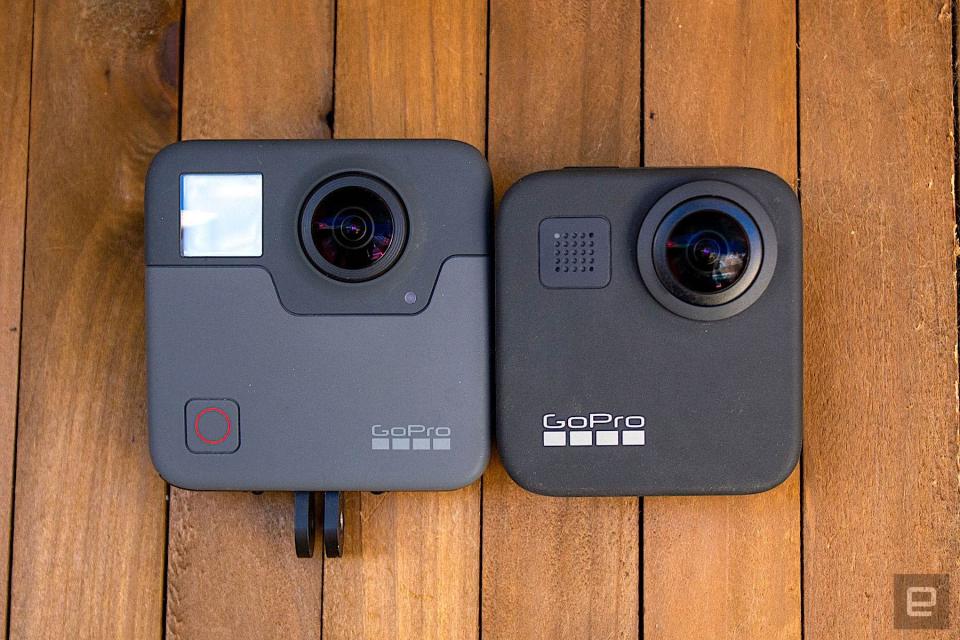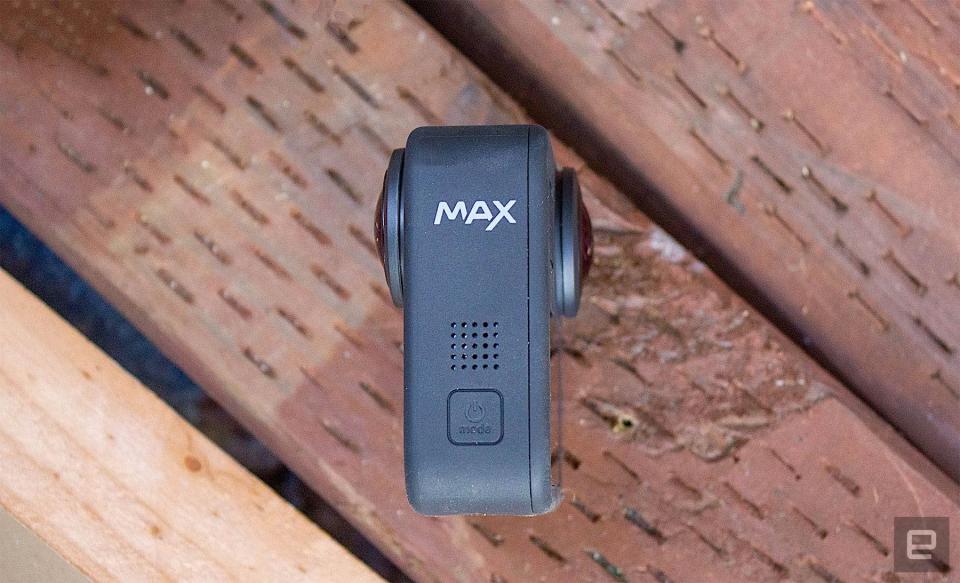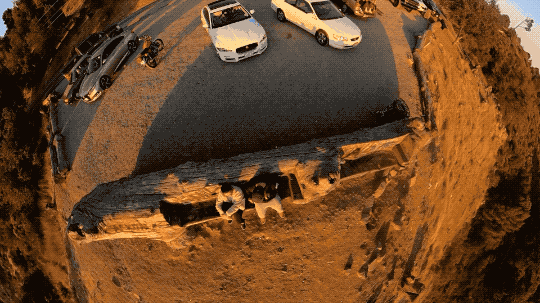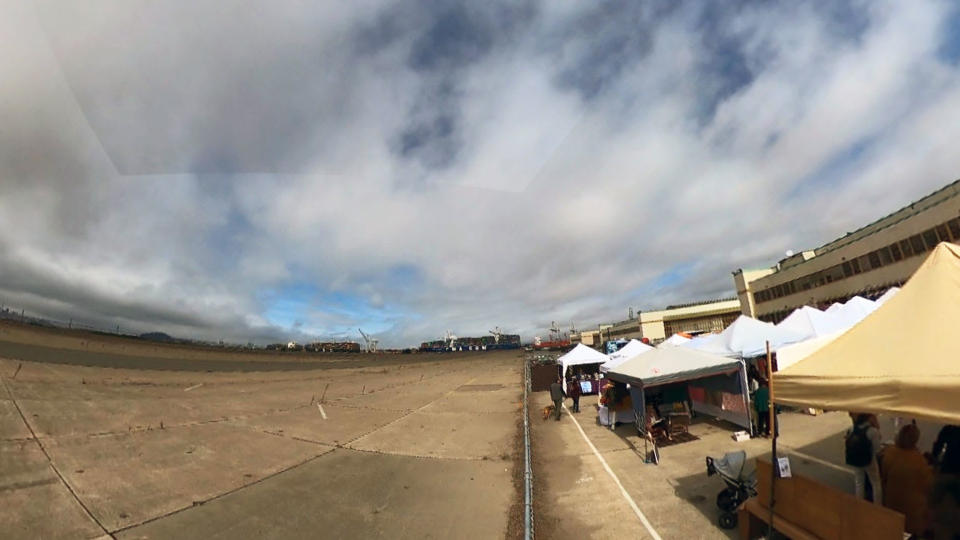GoPro Max review: Much more than a 360 camera
The company's second 360-camera is one for the creators.
360-degree video has not caught on. GoPro knows this, and honestly, I don't think the company is really trying to change that. At least in the context of viewing it in a VR headset, or by moving your phone. Despite this review being about the Max -- the company's second stab at a 360-degree camera -- it's clear that regular old "flat" video is the primary focus here. The $499 Max appears to be an attempt at an even-more versatile GoPro, that happens to be pretty capable in the 360-degree world (no pun intended). While I can say right away that Max is a great improvement on Fusion and it doubles as a regular GoPro, it's not for everyone (and that's okay).
Spherical video was briefly popularized during the heyday of mobile-friendly VR (Daydream and Samsung's Gear VR etc.), and as with phone-based VR, the technology soon hit a plateau with consumers. Wrangling 360 files was hard, viewing them in any meaningful way was even harder. You don't need to be a famous director to record a cool video with your phone (or GoPro). But with the 360 format (and Fusion in particular), you had to contend with stitching, where to hold or mount the camera, how to move with it and how to edit the whole mess afterward.
GoPro's Max doesn't slay all of these problems, but it gently persuades you to forget about some of them. It encourages you to think of it as a camera that catches everything, freeing you up to be a bit more in the moment. Of course, this is still a GoPro, so action and adventure are at its heart. But this time around it's more of an advanced GoPro for creators that wanna get funky.

As a reminder, the Max is the spiritual successor to the Fusion but has many key differences. First of all, it's smaller, by about half an inch on its two longest sides. Second, it has a full-color 1.7-inch touchscreen for viewfinding, menu navigation and media playback. The audio has been improved with true-spherical audio (the Fusion was 2D/circular) which can be "focused" in certain directions -- think vloggers recording their voice while the front camera records a scene. There's now only one SD card (hooray) to contend with, and the stitching is done on the camera, not in software (also hooray). Oh, and there's a "Hero" mode so you can use it like a regular ole GoPro, which we'll be talking about a lot.
Fusion was, fairly literally, two GoPros in one case. Max is one camera with two lenses. The result is a lot less leg work (like not having to export files from two SD cards), and a whole host of other usability tweaks. In practice, this makes the Max a much less daunting, much smaller and cheaper proposition. Though it's not without some quirks.
Before we get to those, though, there are a few other hardware changes to point out. The first is something we saw debut in the Hero 8: built-in, foldable mounting fingers. The Fusion had the mounting fingers built-in too, but now they fold neatly into the base of the camera. On the Max, there's a new battery door, which normally I wouldn't mention, but this one kept popping off if I opened it too enthusiastically. Not a huge problem, but a minor annoyance clipping it back on.
Once again, there are two lenses and neither is protected by a glass cover -- unlike the Hero line. You will have rubber caps to protect them when it's turned off, and there are protective plastic caps to keep them safe while in use, but there's possibly a small trade-off in clarity.
Hero mode
Perhaps the simplest difference between Fusion and Max, is that the Max can be used as a regular GoPro right out of the box. Fusion always shot in 360 mode, and you then "punched out" a flat video or photo after the fact. With Hero mode on the Max, you simply press a button on the screen, and it'll shoot regular (non-360) video, photos or TimeWarps.
And yes, you can choose which camera to use (front or back) via an on-screen toggle. Right now, you can't toggle between the two while recording, but GoPro tells me this is a feature it's considering, albeit with no immediate timeline.

While Hero mode instantly makes the Max more practical and versatile, know that there are some limitations. There are also some perks, so your specific needs will determine which outweighs the other.
The main limitation in Hero mode, compared to a regular GoPro, is that there are far fewer shooting modes. There's no 4K at all, no 2.7K and no real slo-mo to speak of, though it'll shoot up to 60fps in most modes. Basically you have either 1080p or 1440p (4:3) at 60, 30 or 24 frames per second, and that's your lot.
Similarly, there's no "burst" mode for photos or any photo night modes, or LiveBurst (new to the Hero 8). TimeWarp is here, and so is regular TimeLapse, but there's no night lapse (or any of the night modes at all).
But what about the good stuff? Well, the Hero 8 came with HyperSmooth 2.0, which was GoPro's improved on-camera stabilization. With the Max we have "Max HyperSmooth," which theoretically is even better. You might be shooting in "Hero" mode, but thanks to the camera's all-seeing-eyes, it can use that broader field of view to provide a lot more headroom for stabilization buffering. Note that the Hero 8 has four different tiers of stability (off, on, HyperSmooth 2.0 and Boost). The Max only has two options: off, or Max.
Another trick you can do with the Max that you can't with a regular GoPro (or phone camera) is
"Power Pano." In short, you can grab a 270-degree photo panorama with a single click. No more gingerly moving your phone left-to-right to capture that vista (and have it ruined by a moving object). With Power Pano, simply grab it in one go like a regular photo.
The last two features to get a "Max" upgrade are TimeWarp and horizon leveling. Now, you can move the view of your TimeWarp around over time (like you were moving your head as you walk) after the fact. You can also apply horizon leveling at the time of capture, instead of after the fact in the app. Horizon leveling is also much more capable than on the Hero 8. In fact, you can rotate the camera 360-degrees as you record, and the horizon won't move at all. I imagine a snowboarder pulling a corkscrew, yet the horizon doesn't move, only the rider does. Needless to say, it's a solid feature and baked right into the menu this time.

Max HyperSmooth
When I recently reviewed the Hero 8, one of the best updates was the new and improved HyperSmooth stabilization. It took the Hero 7's already-impressive feature, and ratcheted it up a few notches. On Max, it's even better again -- thanks to that extra buffering available to each 180-degree lens.
In my testing, I pitted the Hero 8 in "Boost" mode (the most stabilization) against the Max's stabilization, which GoPro has frustrated writers by calling Max HyperSmooth. Boost on the Hero 8 is weirdly smooth, as I noted in my review and is therefore not well suited to all activities, in my opinion. So it feels a little counterintuitive for me to say that Max's Max HyperSmooth is smoother again (GoPro, see what you're making us write), yet it feels more suitable for action shots. There's something about how it handles leans and turns and other anatomical movements that seems a bit more natural -- and it doesn't appear to be cropping like the Hero 8.
In 360 mode, all clips are stabilized by default (aka, there's no option to turn it off). I'm not sure why you'd want to, either, but there's going to someone somewhere with a reason. Anyway, know that video, even in spherical mode, is adequately stabilized too.
Max Time (and space) Warp
TimeWarp was new to GoPro for the Hero 7. It was fun, worked pretty well, and that was that. With the Hero 8, GoPro made it better by using the camera's sensors to automatically adjust the speed of the video. In Max, it works a little differently, depending on what mode you're in.
In Hero mode, TimeWarp works the same as in the Hero 8. You can choose your speed increase rate (10x, 5x and so on), or let the camera figure it out for you. But you're stuck with the view of whatever you were pointing the camera at while you record. In 360 mode, however, you have a little more flexibility, and can "move" the camera around to focus on anywhere you like after the fact, making your TimeWarps all the more dynamic and interesting. The one trade-off is that you can't use "auto" mode here. So you're back to picking a speed manually and hoping it delivers. I will say though, that the trade-off might be worth it. TimeWarps can easily be ruined by having the camera pointing slightly off-center as you walk. With Max, you can keep it locked right in front of you, or conversely pan around for effect.

In fact, in 360 mode, you can edit a TimeWarp in the same way you can edit a 360 video. That's to say, you can zoom in, pan around with transitions, rotate the camera to any angle and so on. This actually puts a whole new creative spin on TimeWarps that combines with their "fast forward" nature really well.
I set one going at home, and walked around the camera going about my business. Later, I was able to make something that almost looked like a multi-camera setup. With shots on my face, the other side of the room, twisting up to the ceiling and then zooming back out down to me again. It's clever, dynamic and a lot of fun. I can imagine plenty of folks more creative than me doing some really interesting things with this.
Power Pano
We've all tried to take a panorama with our phones. You know how it goes, you try and slowly move the camera from one side to the other while staying within the lines, yet somehow you're shaking like a leaf and have lost all sense of hand-eye coordination. In the end, you have a slightly wonky image, with a caterpillar dog in it. With Max, that's no longer a problem.
Although it's not quite the sort of feature you'd base a whole purchase on, it's definitely a nice perk. A few years ago, I went through a phase of taking panoramas but quickly stopped. It was just too hit and miss and took too much time. With Max, it's just one button push, and you get a precise moment in time, rather than a collage over many seconds (and thus those famous squashed/extended limbs and animals). The thing to consider here is that your phone is designed for more conventional portrait and landscape photography (i.e. less wide and less distortion). Therefore, you might prefer the actual image you get from your phone, but with Max it's easier and better for grabbing action.

If there was a negative, it's that you have less control over how wide your shot is. With a phone, you can pan as much or as little as you'd like. With Max, you're stuck with 270 degrees. But hey, there's always Photoshop if you need to trim a little.
Max SuperView
GoPro was vocally proud of SuperView when it first launched on the Hero 3+. It's billed as a more immersive view that squeezes every pixel from the (4:3) sensor into the more common 16:9 format. With Max, SuperView shoehorns even more of the scene into your shot. If your activity is fast, dynamic and preferably shot from your point of view, SuperView is a good choice.
Max SuperView is about 26-degrees wider again than on a regular GoPro and tops out at 149-degrees field of view. You won't want to use it all the time, as it's definitely situation-specific, but it's another feather in the utility cap for Max that you won't find on the Hero line.
Horizon leveling
This was an underrated new feature on the Hero 8 -- the ability to correct footage that was a little lopsided (say, if you'd mounted your camera leaning a little to one side). The main problem with it on the Hero 8, is that the feature is hidden away in the app (which also means you have to use the app).
With Max, leveling is done right on the camera and in real-time. What's more, with a Hero 8, any leveling comes at the expense of some image crop, as the app is basically zooming in a little to prevent black edges as the image rotates. Because Max can "see" so much more, it doesn't need to crop at all. And there's no hard limit like there is on a Hero. You can literally rotate the camera through 360 degrees, several times, and your footage will stay locked on the Horizon (if you so wish, of course).
Let's be clear, GoPro isn't the first to do this -- cameras like the Insta360 line can do similar -- but it's impressive all the same (and could be put to some very creative use). This is handy because Max suffers a quirk I also spotted on the Hero 8: The built-in mount fingers have a little bit of "wiggle" in them. Once you mount it and tighten the pin, you can nudge the camera a little off-axis so it's no longer flat in the mount.
I initially thought it was an issue with the tightness of the mounting pin, but it happens even when you can't tighten it anymore. It's not egregious, but it can be annoying if you don't realize until after the fact. Either way, horizon leveling to the rescue? Let's just hope that the next generation eliminates the minor mounting issue.

Audio
One of the features GoPro was keen to highlight at Max's launch was the spherical audio. Fusion had "circular" audio, that recorded around the camera in something like a flat, 360-degree disc. Max, on the other hand, records spherical "ambisonic" audio via the six microphones onboard. In theory, this gives your audio more presence in space, but in practice, it's hard to tell, especially if you're playing it back on a phone or laptop speakers.
To test it, I placed the Hero 8 and Max side-by-side and recorded a live band. In the audio player below, the music starts with the recording from the Max and then alternates between that and the Hero 8 every ten seconds. You'll hear that the sound from the Max has a lot more "space" and dynamic range, but is also a little muddier. The sound from the Hero 8 is much narrower and flatter but brighter. The Hero 8's high-end frequencies can pop through a little more, but the Max delivers a much more robust recording overall with drum sounds popping through more and a wider sound stage, even if it does feel a little subdued (this may also be due to camera placement).
There are also audio settings that let you choose where the microphones will focus, and these have a more practical application. When the Max was announced, GoPro repeatedly mentioned the camera's vlogging credentials. The ability to record front, then back, superior stability and directional audio. For the latter, you'll dive into a setting under the Protune menu. Here, you tell the camera to focus on audio from either the front lens, the back or both. So, if you're "behind" the camera conducting an interview, you can have your on-camera subject's sound be the focus. Conversely, if you're speaking to camera, you can have it home in on you.
In practice, it works. But the results I had were mixed. Yes, the audio from the "focused" side was clearer, but in some tests the difference was minimal. In others, more pronounced. So your environment and a few other variables might be a factor here.
360 video editing and the app
Without a doubt, the Achilles heel of 360 video is the editing process. It's no fun. At all. Often you need to jump into a different app and maybe even process the video (stitching), which is never quick. Once done, you have a video that you need to "look" around and try and wrangle into something usable. On top of this, it's easy to mess things up by zooming out too much or trying to keep the horizon level. Needless to say, it's a whole thing.
With Max, GoPro has vastly improved the process compared to Fusion. Basic edits can be done via your phone without too much headache. Whether that's simply exporting a 360-degree video for sharing, or creating a regular video with transitions. The app uses keyframes, which you add to the timeline and then move the camera around to what you want to be in the shot. It works for simple transitions and pans etc, but it can still be a bit of a pain to keep things level, or worse, avoid overdoing the funky effects like tiny planet, or rotating the view (too much of this soon gets distracting).
If you don't want to edit on your phone, GoPro has a dedicated "Player" app for Mac and Windows. I found this a little easier to work with, although it does mean that you'll need to transfer files to the desktop, which adds another link in the chain. But once you do, the extra screen real estate and keyboard shortcuts makes things a little easier.

As mentioned earlier, one thing you won't need to do is stitch any files together. GoPro has moved this process directly onto the camera. For the most part, it does a solid job, without many overlaps or other glitches. They're not totally gone, though. Depending on how you mount the camera (the length of your selfie-stick, for example) you may still see the odd quirk. Also, perhaps the bigger problem is when each lens has to deal with different lighting. If one lens is toward the sun, and the other toward a more shaded area, this will pretty certainly create two different "exposures" which will be obvious in your final footage (one half is lighter than the other etc.). Not a problem unique to Max, but a problem nonetheless.
I also noticed some jittering, particularly when filming stabilized footage in low light. At first it looks like vibration from my footsteps, but often it'll happen when I move the camera left to right etc. Anecdotally, some people have told me about a similar problem with HyperSmooth on the Hero cameras, and it looks like it might have found its way over to Max, too.

Wrap up
I was pretty excited when I first heard about Max. I'm not particularly interested in 360-degree video, but I do like some of the creative tools it brings to regular videos. Max, with its improved stability, superior audio and all-seeing-eye(s) promised to be a GoPro that does things no other GoPro can. That's definitely true, but there are some trade-offs that stop this being the clear choice for those looking for the "best" GoPro.
Most notably, the pared-down video options in Hero mode. If you primarily want to use Max as a regular action camera with some 360 capture perks, then you'll need to think long and hard about whether you need 4K, slow motion or any of the night modes. These might be less razzle-dazzle than a 180-degree rotating pan, but they're much more important to a lot of general users. As for battery life? It will depend on how you use it, but expect similar usage times to the Hero 8 (about an hour of active recording).
Add to this the fact that you have to treat the camera more gently thanks to those two exposed lenses, and again, it might not fit your use case. The bigger footprint means it's not quite as versatile as a regular Hero camera -- especially for certain mounting positions. Even if you can mount it where you want, there's still a little extra work involved in wrangling the files if you want to punch something out of a 360-degree file.

That said, there's undoubtedly a crowd to which the Max will definitely appeal. 270-degree panos? Barrel-rolling videos just because you can? Tiny planet to extreme close up? These are all things that are begging to be experimented with. I can really see some people pulling out mindblowing shots from this that simply are not possible on a regular sports camera. If you have a creative or experimental mind, Max is going to feed your curious side for sure.
For those that want to go the other way, who just want a 360-degree camera that might also double as a regular action cam, then Max makes a good choice. But you might also want to consider something like the similarly-priced Insta360 One X. Especially if higher frame rates/slow motion and HDR are important to you. Either way, Max is a vast improvement over Fusion in every way, and finally makes a 360-degree camera feel less of a novelty, to the point where it's something you actually want to include in your workflow. For most people in the market for an action camera, I'd point you to the Hero 8, but for those who want to add a little creative flair, Max is a beast potentially worth taming.




